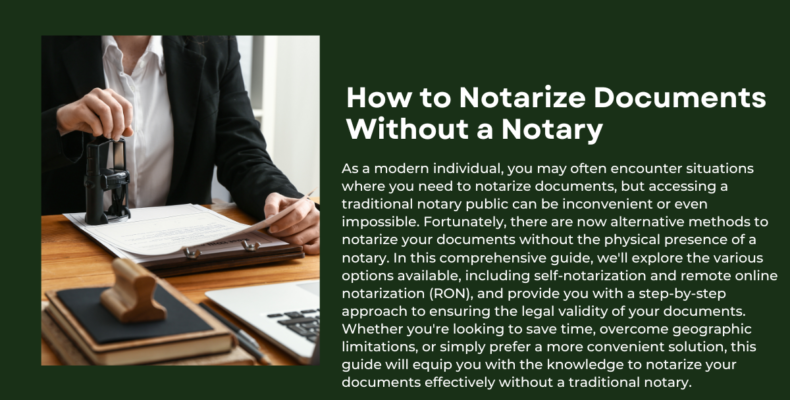As a modern individual, you may often encounter situations where you need to notarize documents, but accessing a traditional notary public can be inconvenient or even impossible. Fortunately, there are now alternative methods to notarize your documents without the physical presence of a notary. In this comprehensive guide, we’ll explore the various options available, including self-notarization and remote online notarization (RON), and provide you with a step-by-step approach to ensuring the legal validity of your documents. Whether you’re looking to save time, overcome geographic limitations, or simply prefer a more convenient solution, this guide will equip you with the knowledge to notarize your documents effectively without a traditional notary.
Understanding the Legality of Notarizing Documents Without a Notary
In many jurisdictions, there are alternative methods to notarize documents without the physical presence of a notary public. These alternative methods, often referred to as “self-notarization” or “remote online notarization” (RON), are legally recognized in an increasing number of states and can provide a convenient solution for individuals and businesses.
It’s important to note that the legality and specific requirements for notarizing documents without a notary may vary depending on your location. Before proceeding, it’s recommended to check the laws and regulations in your state or jurisdiction to ensure that the method you choose is legally valid.
How to Notarize a Document Without a Notary Section?

Documents such as affidavits, power of attorney forms, and real estate deeds often require notarization. However, there are times when these documents may lack a specific section for notary acknowledgment. This can happen due to oversight, outdated templates, or simply because the document was created in a jurisdiction where notarization is not a standard requirement.
In some cases, documents are drafted without a notary section because the parties involved are unaware of the notarization requirement, or they may have used a generic template that doesn’t include it. Additionally, documents originating from foreign countries may have different formatting standards.
Preparing for Notarization
Before you can add a notary section, ensure you have all the required information. This includes the names of the signatories, their identification, and any specific details about the transaction or agreement.
Make sure the document is fully completed and that all parties have signed where necessary. A notary cannot notarize an incomplete or unsigned document.
Adding a Notary Acknowledgment
A notary acknowledgment is a statement attached to a document certifying that the signatory personally appeared before the notary, was identified by the notary, and acknowledged signing the document freely and willingly.
There are various types of notary acknowledgments, including individual, corporate, and partnership acknowledgments. Each type caters to different entities and should be chosen based on the context of the document.
Creating a Notary Certificate
Steps to create a notary certificate
- Identify the type of acknowledgment needed: Determine whether the acknowledgment should be individual, corporate, or for another entity type.
- Draft the acknowledgment wording: Include the notary’s name, the date, the location, and a statement confirming the identity and willingness of the signatory.
- Attach the certificate to the document: This can be done by stapling or securely attaching it in a way that it becomes an integral part of the document.
Alternative Notarization Methods

Remote Online Notarization (RON):
- RON allows a notary public to verify the signer’s identity and witness the signing of the document remotely, using video conferencing technology.
- To use RON, you’ll need to find a registered remote notary, schedule a video conference session, prepare the document, and gather your identification.
- The availability and specific requirements for RON can vary by state, so it’s crucial to research the laws in your area.
Self-Notarization: Notarizing Documents Without a Notary
Self-notarization, also known as “self-attestation” or “self-verification,” is a method of notarizing documents without the involvement of a traditional notary public. This approach involves the signatory, or the person signing the document, taking on the responsibility of verifying the authenticity of their own signature.
Here’s a step-by-step guide to self-notarizing your documents:
- Prepare the Document: Ensure that the document you need to notarize is complete and signed by all necessary parties.
- Gather Identification: Collect a valid government-issued ID, such as a driver’s license or passport, to provide proof of your identity.
- Create a Self-Notarization Statement: Prepare a self-notarization statement that includes the following information:
- Your full legal name
- The date and location where you are signing the document
- A statement affirming that you are the person signing the document and that your signature is genuine
- A statement indicating that you are aware that making a false statement may subject you to penalties
- Sign the Self-Notarization Statement: Carefully read the self-notarization statement, and then sign it in the presence of a witness (if required by your state or jurisdiction).
- Attach the Self-Notarization Statement: Attach the signed self-notarization statement to the document you need to notarize.
It’s important to note that the specific requirements for self-notarization may vary by state or jurisdiction. Some states may require the presence of a witness, while others may have additional guidelines or restrictions. Be sure to research the laws and regulations in your area before proceeding with self-notarization.
Choosing the Right Notarization Method for Your Needs:
When deciding on the best method to notarize your documents without a traditional notary, consider the following factors:
- Legality and Compliance: Ensure that the method you choose is legally recognized in your state or jurisdiction and complies with all applicable laws and regulations.
- Convenience and Accessibility: Evaluate the ease of use and accessibility of the notarization method, especially if you have limited access to a physical notary public.
- Cost Considerations: Compare the costs associated with different notarization options, as some remote or self-notarization services may have fees.
- Security and Authenticity: Assess the level of security and authenticity provided by the notarization method to ensure the document’s integrity.
- Familiarity and Comfort: Consider your own level of familiarity and comfort with the notarization process, as this can impact your overall experience.
By weighing these factors, you can make an informed decision and choose the notarization method that best suits your needs and circumstances.
Troubleshooting Common Issues with Notarizing Documents Without a Notary:
While the process of notarizing documents without a traditional notary can be relatively straightforward, there may be some common issues that you encounter. Here are a few potential challenges and how to address them:
- Legality Concerns: If you’re unsure about the legality of a particular notarization method in your state or jurisdiction, reach out to a legal professional or the appropriate government agency for guidance.
- Difficulty Accessing Remote Notary Services: If you’re having trouble finding or scheduling a remote online notarization service, consider alternative methods, such as self-notarization or checking with your local government offices for any available remote notary options.
- Rejection of Self-Notarized Documents: In some cases, the party receiving your self-notarized document may not accept it. If this occurs, you may need to explore other notarization options or provide additional documentation to support the validity of your self-notarization.
- Technical Issues with Remote Notarization: If you encounter any technical problems during a remote online notarization session, such as poor video or audio quality, be sure to communicate with the notary and try to resolve the issue. If necessary, you may need to reschedule the session.
- Uncertainty About Document Authenticity: If the recipient of your notarized document is concerned about its authenticity, provide them with any supporting documentation or information about the notarization method you used to help alleviate their concerns.
By being proactive and addressing any issues that arise, you can help ensure a smooth and successful notarization process, even without the physical presence of a traditional notary public.
FAQs
What is the legal status of self-notarization or remote online notarization (RON) in my state?
Answer: The legal status of alternative notarization methods can vary significantly by state and jurisdiction. Before attempting to notarize a document without a traditional notary, it’s crucial to research the specific laws and regulations in your area. This will help ensure that the method you choose is legally recognized and valid. If you’re unsure about the legality, it’s best to consult a legal professional or the appropriate government agency for guidance.
How do I find a reliable remote notary service to notarize my document online?
Answer: Identifying a trustworthy remote notary service can be challenging, as the availability and requirements for RON can differ by state. Start by searching for “remote online notary” or “virtual notary” services that are authorized to operate in your jurisdiction. Look for providers that are transparent about their processes, have positive customer reviews, and comply with all applicable laws and regulations. You can also check with your state or local government for any recommended or approved remote notary options.
What are the steps involved in self-notarizing a document, and what requirements do I need to follow?
Answer: The self-notarization process typically involves creating a self-attestation statement, signing it in the presence of a witness (if required), and attaching it to the document you need to notarize. However, the specific requirements can vary significantly by state or jurisdiction. Before attempting to self-notarize, be sure to research the guidelines in your area, such as the necessary content for the self-attestation statement, the presence of a witness, and any other local regulations. Following the correct steps and requirements is crucial to ensure the legal validity of your self-notarized document.
What types of identification do I need to provide when notarizing a document without a notary?
Answer: When notarizing a document through self-notarization or remote online notarization, you’ll typically need to provide a valid government-issued ID, such as a driver’s license or passport, to verify your identity. The notary or service provider may have specific requirements for the type of ID they will accept, so it’s important to check their guidelines before the notarization process. Ensuring that you have the appropriate identification can help streamline the notarization and prevent any delays or issues.
How can I troubleshoot issues that arise during the remote online notarization (RON) process?
Answer: If you encounter any technical problems or other challenges during a remote online notarization session, such as poor video or audio quality, it’s important to communicate openly with the notary and try to resolve the issue. If necessary, you may need to reschedule the session. Additionally, if the recipient of your notarized document has concerns about its authenticity, be prepared to provide them with supporting documentation or information about the notarization method you used. By being proactive and addressing any issues that arise, you can help ensure a smooth and successful notarization process, even without the physical presence of a traditional notary public.

